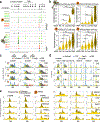Chromatin establishes an immature version of neuronal protocadherin selection during the naive-to-primed conversion of pluripotent stem cells
- PMID: 31740836
- PMCID: PMC7061033
- DOI: 10.1038/s41588-019-0526-4
Chromatin establishes an immature version of neuronal protocadherin selection during the naive-to-primed conversion of pluripotent stem cells
Abstract
In the mammalian genome, the clustered protocadherin (cPCDH) locus provides a paradigm for stochastic gene expression with the potential to generate a unique cPCDH combination in every neuron. Here we report a chromatin-based mechanism that emerges during the transition from the naive to the primed states of cell pluripotency and reduces, by orders of magnitude, the combinatorial potential in the human cPCDH locus. This mechanism selectively increases the frequency of stochastic selection of a small subset of cPCDH genes after neuronal differentiation in monolayers, 10-month-old cortical organoids and engrafted cells in the spinal cords of rats. Signs of these frequent selections can be observed in the brain throughout fetal development and disappear after birth, except in conditions of delayed maturation such as Down's syndrome. We therefore propose that a pattern of limited cPCDH-gene expression diversity is maintained while human neurons still retain fetal-like levels of maturation.
Conflict of interest statement
COMPETING INTERESTS STATEMENT
Martin Marsala is the scientific founder of Neurgain Technologies, Inc. and has an equity interest in the company. In addition, Martin Marsala serves as a consultant to Neurgain Technologies, Inc., and receives compensation for these services. The terms of this arrangement have been reviewed and approved by the University of California, San Diego in accordance with its conflict of interest policies.
Figures






References
-
- Gul IS, Hulpiau P, Saeys Y & van Roy F Evolution and diversity of cadherins and catenins. Exp. Cell Res. 358, 3–9 (2017). - PubMed
-
- Hirayama T & Yagi T Regulation of clustered protocadherin genes in individual neurons. Semin. Cell Dev. Biol 69, 122–130 (2017). - PubMed
-
- Mountoufaris G, Canzio D, Nwakeze CL, Chen WV & Maniatis T Writing, Reading, and Translating the Clustered Protocadherin Cell Surface Recognition Code for Neural Circuit Assembly. Annu. Rev. Cell Dev. Biol 34, 471–493 (2018). - PubMed
Publication types
MeSH terms
Substances
Grants and funding
LinkOut - more resources
Full Text Sources
Medical
Molecular Biology Databases

